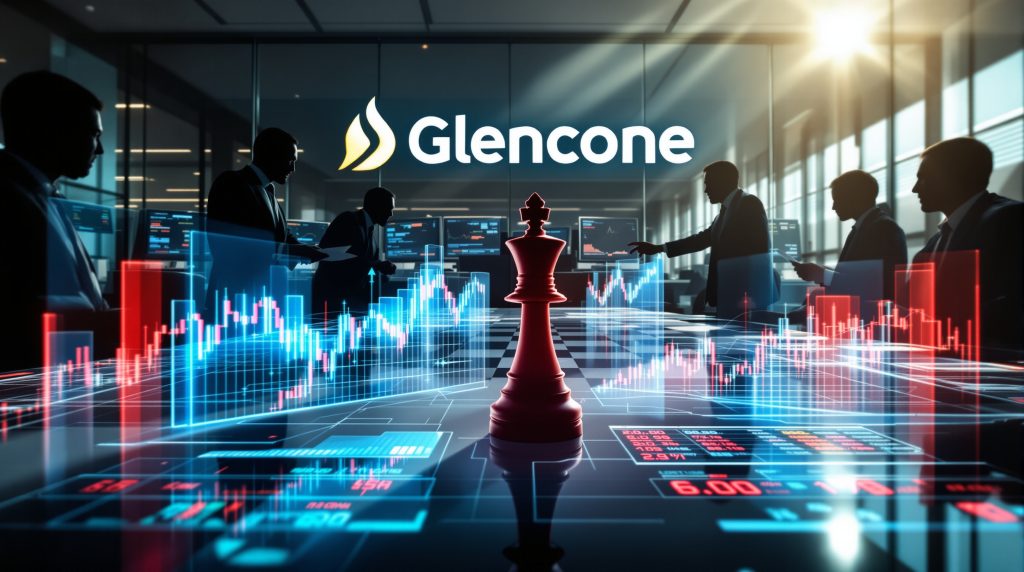Leadership Transitions at Glencore: What's Behind the Oil and Gas Trading Shake-Up?
Glencore, one of the world's largest commodity traders, is experiencing significant leadership changes in its oil and gas trading division, signaling broader strategic shifts in how the company positions itself in volatile energy markets. The departure of a senior executive with nearly two decades of service marks another chapter in an ongoing reorganization of the company's trading operations as the company navigates through an oil price rally affecting market dynamics.
How is Glencore's Trading Division Evolving in 2025?
Glencore's trading division is undergoing substantial transformation this year, characterized by high-profile leadership changes across multiple commodity desks. These transitions reflect both internal reorganization efforts and external market pressures as the company adapts to changing industry evolution trends.
The company's energy and coal trading unit recently posted one of its worst performances on record, according to industry reports, creating momentum for strategic realignment. This challenging performance backdrop provides important context for understanding the current wave of leadership transitions.
Key Leadership Changes Reshaping Glencore's Trading Operations
The reorganization affects multiple commodity trading segments, with senior leaders departing across oil and gas, coal, nickel, and aluminum divisions. These changes appear to be part of a coordinated effort to refresh trading strategies and improve operational efficiency in response to market challenges.
Internal promotions are playing a significant role in this transition, with specialized expertise being elevated from within. This approach suggests Glencore is balancing the need for fresh perspectives with the value of institutional knowledge and continuity.
The pattern of departures and replacements indicates a deliberate restructuring rather than reactive responses to individual career decisions. Industry analysts note that Glencore appears to be strategically repositioning its trading leadership structure to better navigate increasingly complex commodity markets.
Who is Leaving Glencore's Oil and Gas Trading Division?
Alex Sanna, head of Glencore's oil and gas trading team, has decided to step down after guiding the division for six years and spending almost two decades with the company. This departure represents a significant shift in the company's trading leadership structure, removing a veteran presence from a key trading desk.
Sanna's leadership tenure coincided with Glencore's strategic expansion of its energy asset portfolio, as the company worked to complement its trading operations with physical infrastructure. His departure comes at a pivotal moment as the company continues evolving its approach to energy markets.
Profile of the Departing Executive
Sanna's nearly 20-year tenure with Glencore established him as a fixture in the company's trading operations. Industry sources note that such lengthy careers with a single trading house are becoming less common in the increasingly competitive commodity trading landscape.
His six-year leadership of the oil and gas trading division covered a period of significant market volatility and strategic development for Glencore. During his tenure, the company expanded its physical energy assets to complement trading operations, including major acquisitions in refining and storage infrastructure.
The timing of his departure at year-end 2025 allows for a managed transition, with his replacement already identified from within the company's existing leadership ranks. This orderly succession planning suggests the departure was anticipated rather than sudden.
What's Behind the Wave of Senior Departures at Glencore?
The oil and gas trading head's exit is part of a broader pattern of senior management changes at Glencore throughout 2024-2025. These transitions span multiple commodity desks and appear to reflect both performance challenges and competitive pressures from rival trading houses.
Timeline of Recent Executive Transitions
Ruan van Schalkwyk, Glencore's coal trading head, retired earlier in 2025 shortly after the energy and coal trading unit posted disappointing results. This timing suggests possible connections between performance metrics and leadership changes.
Jason Kluk, who led Glencore's nickel and ferroalloy trading operations, departed in November 2024, representing another significant loss of senior trading expertise from the company.
Sam Imfeld, a longstanding trader in Glencore's aluminum and alumina team, left for competitor Vitol Group in early 2025. This move highlights the competitive recruitment environment among major trading houses, as reported by Mining.com.
Industry reports indicate other senior traders received offers from rival trading houses but chose to remain with Glencore, including Peter Hill (head of iron ore trading) and Jyothish George (subsequently promoted to head of metals, iron ore and coal trading).
Performance Challenges Driving Reorganization
The energy and coal trading unit recently posted one of its worst performances on record, creating pressure for operational changes and fresh leadership approaches. This challenging performance provides important context for understanding the current wave of transitions.
A strategic review of trading operations appears to be underway following these disappointing results, with restructuring efforts aimed at improving market responsiveness and trading outcomes across commodity desks.
The company faces competitive pressure from rival trading houses that are actively expanding their portfolios. This includes traditional energy traders moving into metals markets, creating a more complex competitive landscape that requires strategic adaptation.
How is Glencore Reshaping its Energy Trading Strategy?
The leadership transition comes at a pivotal time for Glencore's energy trading operations as the company works to expand its asset base and strengthen its market position. Recent strategic acquisitions highlight the company's commitment to building a more robust energy portfolio while adapting to trade war impacts on global supply chains.
Recent Strategic Energy Acquisitions
Glencore purchased Shell's Singapore refining and chemicals business in 2024, significantly expanding its downstream energy operations in a key regional market. This acquisition represents a major step in building physical asset infrastructure to complement trading activities.
The company established a joint venture investment in Africa's largest oil storage facility earlier in 2025, strengthening its logistical capabilities in a strategically important region. This investment enhances Glencore's ability to manage physical oil flows and optimize trading opportunities.
These acquisitions reflect ongoing efforts to balance trading operations with physical assets, creating a more integrated approach to energy markets. Industry analysts note that this strategy helps reduce trading volatility and provides structural advantages in market positioning.
The company's strategic push to expand its energy portfolio beyond traditional mining operations represents a significant evolution in its business model. While Glencore remains primarily known for its metals and minerals business, these investments signal serious ambitions in energy markets.
New Leadership Direction
Maxim Kolupaev, who currently leads Glencore's LNG, gas, and power trading operations, will replace Sanna as head of oil and gas trading. This internal promotion brings specialized experience from growing market segments to the broader oil and gas trading leadership.
The selection of leadership from the LNG and power trading segments signals potential strategic emphasis on these growth areas within the broader energy portfolio. Industry observers note that LNG in particular represents an increasingly important component of global energy markets.
Restructuring responsibilities across commodity trading desks appears to be part of a broader effort to improve operational efficiency and market responsiveness. This reorganization may allow for more specialized focus within particular market segments.
Integration between energy trading and physical asset operations is likely to remain a key strategic priority under new leadership. The complementary relationship between trading activities and infrastructure investments provides structural advantages in volatile markets.
What Does This Mean for Glencore's Market Position?
The leadership changes at Glencore occur against a backdrop of intense competition in global commodity trading and shifting market dynamics. These transitions may signal evolving strategic priorities as the company works to maintain competitive advantages in challenging markets.
Competitive Landscape Analysis
Rival trading houses are actively recruiting talent from established players, creating pressure on retention of key personnel. Vitol Group in particular has targeted Glencore traders, successfully recruiting some while others chose to remain despite competitive offers.
Traditional oil traders are expanding into metals markets, creating new competitive pressures and blurring traditional boundaries between commodity trading segments. This convergence requires trading houses to develop broader expertise across multiple commodity classes.
Industry consolidation trends are reshaping the commodity trading sector, with scale becoming increasingly important for maintaining competitive advantages. Larger trading houses benefit from capital resources, risk management capabilities, and market intelligence that smaller players struggle to match.
The battle for specialized trading expertise has intensified across the industry, with experienced traders commanding premium compensation and leadership opportunities. This talent competition creates both challenges and opportunities for major trading houses as they manage succession planning.
Strategic Implications for Glencore
The reorganization potentially signals shifts in Glencore's trading approach and risk appetite as new leadership brings fresh perspectives to key desks. Industry analysts suggest that leadership transitions often create opportunities to reassess strategies and risk parameters.
Current market conditions present both challenges and opportunities, with commodity price volatility creating potential for trading profits but also increasing operational risks. New leadership may implement different approaches to managing this volatility.
Balancing trading operations with a growing physical asset portfolio remains a central strategic challenge. The integration of these business components requires careful management to maximize synergies while minimizing operational complexities.
The appointment of new leadership with specialized expertise in growing energy segments may accelerate innovation in trading approaches and market positioning. This could include greater emphasis on LNG and power trading, areas of increasing importance in global energy markets.
How Does This Compare to Other Major Commodity Traders?
Glencore's leadership transitions reflect broader industry trends as major trading houses adapt to changing market conditions and competitive pressures. Similar patterns can be observed across the commodity trading sector as firms navigate complex market dynamics.
Industry-Wide Leadership Transitions
Several major trading houses are experiencing senior management changes as part of generational transitions and strategic realignments. This pattern suggests structural shifts in the industry rather than circumstances unique to Glencore.
A broader generational transition is occurring across the commodity trading sector as veteran traders reach retirement age or pursue new opportunities. This demographic shift creates both challenges in knowledge retention and opportunities for fresh perspectives.
Competition for specialized trading talent has intensified across the industry, with traders possessing expertise in specific commodity segments particularly valued. This has created a more dynamic labor market for trading professionals compared to historical patterns.
Trading houses are increasingly expanding beyond traditional commodity segments, requiring leadership with broader expertise and strategic vision. This diversification creates new requirements for management capabilities and market knowledge.
Comparative Analysis of Trading House Strategies
Different trading houses are pursuing varying strategic approaches, with some focusing on asset-light trading operations while others pursue vertical integration strategies similar to Glencore's approach. These divergent models create distinct competitive positioning and risk profiles.
Approaches to energy transition vary significantly among major trading houses, with some aggressively pursuing electrification and decarbonisation opportunities while others maintain stronger focus on traditional hydrocarbon markets. These strategic choices will likely have significant long-term implications for competitive positioning.
Risk management philosophies also differ substantially across the sector, with varying approaches to market exposure, hedging strategies, and capital allocation. These differences reflect both strategic choices and organizational risk cultures.
Trading houses are balancing specialization and diversification in different ways, creating distinct competitive profiles and market positions. Some firms are deepening expertise in particular commodity segments while others pursue broader portfolios to manage market cyclicality.
What Are the Financial Implications of These Trading Division Changes?
The reorganization of Glencore's trading leadership comes with potential financial implications for the company's performance and strategic direction. While specific financial metrics remain confidential, industry observers note several potential impacts.
Trading Division Performance Metrics
The energy and coal trading unit recently faced significant performance challenges, posting what industry sources described as one of its worst results on record. This underperformance likely influenced decisions regarding leadership changes and strategic realignment.
Trading operations historically provide a substantial portion of Glencore's corporate earnings, making the performance of these divisions critically important to overall financial results. The trading business typically offers more consistent returns compared to the volatility of mining operations.
Leadership changes appear aimed at improving financial outcomes through fresh approaches and potentially different risk management strategies. New leadership often brings opportunities to reassess trading parameters and market positioning.
Market conditions create both challenges and opportunities for trading profits as commodity price volatility generates potential trading opportunities while also increasing operational risks. The ability to navigate this volatility effectively will be crucial for future financial performance.
Investor Perspective on Leadership Transitions
Leadership stability is typically valued by investors in commodity trading sector, with experience and institutional knowledge considered important assets. Significant management transitions may raise questions about strategic continuity and operational execution.
Strategic continuity questions arise from multiple senior departures, potentially creating investor uncertainty about future direction and performance expectations. Effective communication regarding succession planning and strategic vision becomes particularly important during such transitions.
New trading approaches under fresh leadership may improve performance metrics over time if they successfully address previous operational challenges. Investors will likely focus on early performance indicators following leadership transitions.
The balance between trading operations and physical assets remains a key focus for investors analyzing Glencore's business model. This integrated approach provides potential competitive advantages but also creates operational complexity that requires effective management.
How Might This Impact Glencore's Future Energy Trading Operations?
The leadership transition creates both challenges and opportunities for Glencore's energy trading operations going forward. Several potential impacts merit consideration as the new leadership team implements their vision.
Potential Strategic Shifts
A rebalancing between different energy trading segments may occur under new leadership, potentially with greater emphasis on growing markets like LNG and power trading. Kolupaev's background suggests particular expertise in these areas.
The leadership transition provides opportunity to implement new trading methodologies and approaches that may better address current market challenges. Fresh perspectives often bring innovation in risk management approaches and market positioning.
Closer integration between trading and physical asset operations could emerge as a strategic priority, maximizing synergies between these complementary business components. The recent acquisitions in refining and storage infrastructure provide additional opportunities for integrated operations.
Certain energy market segments with growth potential may receive renewed focus under new leadership. Industry analysts note that LNG in particular represents a rapidly evolving market with significant trading opportunities, especially following the recent critical minerals order affecting resource markets.
Outlook for Energy Trading Division
The incoming leadership brings specialized expertise in LNG segment, an increasingly important component of global energy markets. This background may influence strategic priorities and trading approaches across the broader energy portfolio.
Restructuring efforts could enhance operational efficiency and market responsiveness if successfully implemented. Organizational changes often aim to streamline decision-making and improve information flow across trading operations.
Recent strategic acquisitions provide opportunities for more effective trading operations through enhanced infrastructure capabilities. The integration of trading activities with physical assets can create structural advantages in market positioning.
Innovative approaches to energy market volatility may emerge under new leadership as fresh perspectives address persistent challenges. Different risk management strategies or market positioning could potentially improve trading outcomes in volatile conditions.
What Does This Reveal About Commodity Trading Career Trajectories?
The departure of senior trading executives highlights interesting patterns in commodity trading career paths and industry talent dynamics. Several observations emerge from analyzing these leadership transitions.
Career Patterns in Commodity Trading
Long tenures remain common among senior commodity traders, with many executives spending decades with a single firm. Sanna's nearly 20-year career with Glencore exemplifies this pattern, though industry observers note increasing mobility among trading professionals.
Specialized expertise in particular commodity segments continues to be highly valued across the industry. This specialization often develops through extended experience with specific markets and trading strategies.
Competition for experienced traders between major trading houses has intensified in recent years. The attempted recruitment of Glencore executives by Vitol illustrates this competitive dynamic.
Career progression increasingly involves cross-commodity experience as trading houses seek leadership with broader perspective and strategic vision. This creates both challenges and opportunities for traders developing their career trajectories.
Talent Management Challenges
Retention of key trading talent has become increasingly challenging as competition for experienced professionals intensifies. Trading houses must balance compensation considerations with organizational culture and career development opportunities.
Knowledge transfer during leadership transitions represents a critical challenge for trading operations. The tacit knowledge accumulated through market experience is difficult to document and transfer through formal processes.
Organizations must balance experienced traders with emerging talent to ensure long-term sustainability. This creates complex succession planning challenges for trading house management.
Specialized expertise in niche commodity segments proves particularly difficult to replace, creating potential vulnerabilities during leadership transitions. The deep market knowledge developed through extended trading experience cannot be quickly replicated.
How Are Commodity Trading Houses Adapting to Changing Market Conditions?
The leadership changes at Glencore reflect broader adaptation strategies as trading houses navigate volatile commodity markets and structural changes in global resource flows. Several important trends can be observed across the industry.
Evolving Trading House Strategies
An increasing focus on physical assets to complement trading operations characterizes the strategies of many major trading houses. This approach helps reduce volatility and provides structural trading advantages through infrastructure control.
Greater specialization within commodity trading teams allows for deeper market expertise and more sophisticated trading approaches. This specialization must be balanced with broader strategic coordination across trading desks.
Enhanced risk management systems and approaches have become increasingly important as market volatility and regulatory scrutiny intensify. Trading houses continue to invest in technology and talent to strengthen these capabilities.
Strategic positioning for energy transition opportunities represents an emerging priority for many trading houses. Different firms are taking varying approaches to balancing traditional commodity exposure with renewable energy opportunities.
Market Condition Responses
Trading houses are adapting to increased price volatility across commodity segments through sophisticated risk management approaches and diversified market exposure. This volatility creates both challenges and opportunities for trading operations.
Navigating geopolitical disruptions affecting global supply chains has become an increasingly important capability for successful trading operations. Political risk assessment and scenario planning have grown in strategic importance.
Positioning for structural changes in energy markets requires careful strategic planning and operational flexibility. Trading houses must balance short-term trading opportunities with longer-term market transformation.
The balance between traditional commodities and emerging resource opportunities varies significantly among major trading houses. Different strategic approaches to this balance create distinct competitive positioning and risk profiles.
FAQ: Glencore's Trading Division Restructuring
When will the current head of oil and gas trading leave Glencore?
Alex Sanna, the current head of oil and gas trading, will depart at the end of 2025 after nearly two decades with Glencore and six years leading the oil and gas trading division. This timeline allows for a measured transition to new leadership.
Who will replace the departing oil and gas trading head?
Maxim Kolupaev, who currently leads Glencore's LNG, gas, and power trading operations, will take over leadership of the oil and gas trading division. This internal promotion suggests continuity in strategic direction while bringing specialized expertise from growing energy segments.
Is this departure part of a larger pattern at Glencore?
Yes, this departure is one of several senior exits from Glencore's trading operations over the past year. Other departures include Ruan van Schalkwyk (coal trading head), Jason Kluk (nickel and ferroalloy trading), and Sam Imfeld (aluminum and alumina trader), suggesting a broader reorganization of trading leadership.
What factors are driving these leadership changes?
The changes appear driven by a combination of performance challenges in the energy trading division, strategic reorganization efforts, competitive pressures from rival trading houses, and natural career progression. The energy and coal trading unit recently posted one of its worst performances on record, likely influencing decisions regarding leadership changes.
How significant is the oil and gas trading division to Glencore's overall operations?
While Glencore is primarily known for its metals and minerals business, the company has been strategically expanding its energy assets and trading operations in recent years. Major acquisitions including Shell's Singapore refining business and investments in storage infrastructure underscore the growing importance of energy operations within Glencore's portfolio.
Further Exploration:
Readers interested in learning more about developments in commodity trading leadership can also explore related educational content at MINING.com, which offers industry news and analysis covering major resource sector companies and market trends.
Want to Capitalise on the Next Major Mining Discovery?
Stay ahead of the market with Discovery Alert's proprietary Discovery IQ model that instantly identifies significant ASX mineral discoveries and transforms complex data into actionable investment insights. Explore historic examples of exceptional returns by visiting Discovery Alert's dedicated discoveries page and begin your 30-day free trial today.




